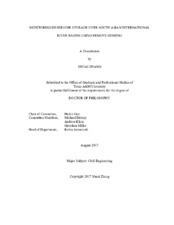| dc.description.abstract | Satellite remote sensing has offered a unique promise for monitoring reservoir storage variations at near real-time. Such information is essential for flood mitigation—especially for regions dominated by international river basins like South Asia. In this dissertation, by using multi-satellite remote sensing observations, a series of algorithms was developed to improve the capability of monitoring reservoir storage variations at high temporal resolution and improved spatial coverage. These algorithms are presented in three studies.
The goal of the first study is to generate a first of its kind remotely sensed reservoir storage dataset for South Asia. Reservoir storage variations were inferred by combining water surface area (obtained by classifying optical satellite images) and elevation measurements (obtained from satellite laser altimeter measurements). This resulted in a 13-year dataset containing estimations for a total of 21 South Asian reservoirs, which represents 28% of the integrated reservoir capacity in the region. The storage estimates were highly correlated with observations—the coefficients of determination (R2) were larger than 0.81, with a normalized root mean square error (NRMSE) ranging from 9.51% to 25.20%.
The second study explores the solution towards monitoring reservoirs at a high temporal resolution under all-weather conditions. Because optical satellite images suffer from cloud contamination during the rainy season, the developed remote sensing reservoir dataset can be restrained from providing the critical information necessary for flood mitigation. A novel algorithm was developed by fusing passive microwave observations with optical satellite observations. This new algorithm has the advantage of working under all-weather conditions, and it reduces the reservoir monitoring time intervals from 10+ days to 4 days.
The third study further extends the spatial representation of the remotely sensed reservoirs from the first algorithm. Although the laser altimeter measurements are able to capture many reservoirs undetectable by traditional radar altimeters, they are still insufficient to form a dense observation network at a basin scale. In order to extend the spatial coverage, a new algorithm was developed to estimate reservoir storage by using water surface area values from MODIS imageries and surface elevation values from Digital Elevation Model (DEM) data (collected by the Shuttle Radar Topography Mission; SRTM). Using the SRTM based method, the spatial coverage of the South Asian reservoir dataset is extended from 28% to 45% of the overall storage capacity in South Asia. | en |


